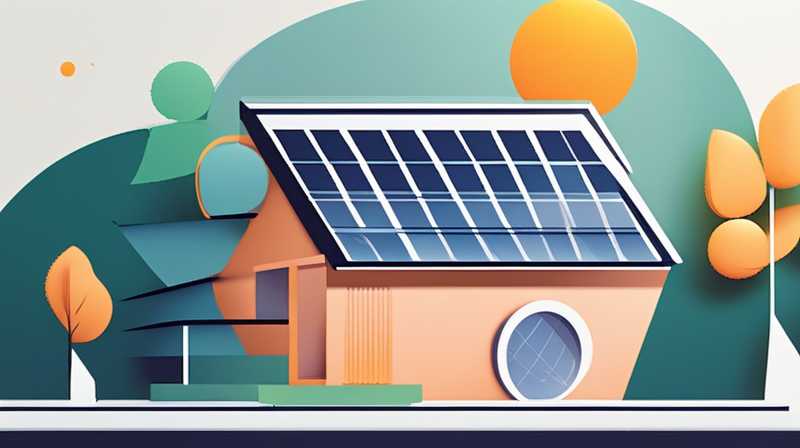
Determining the optimal direction for installing solar lights plays a crucial role in maximizing their efficiency and effectiveness. The preferred orientation typically involves 1. facing south, 2. consideration of sunlight exposure, 3. regional weather patterns, 4. strategic placement. By positioning solar lights to face south, they capture the most sunlight throughout the day, which is particularly beneficial in regions where direct sunlight is abundant.
1. FACING SOUTH: OPTIMAL ANGLE TO MAXIMIZE ENERGY ABSORPTION
Positioning solar lights southward is often deemed the most beneficial approach. When solar lights face south, they tend to absorb the maximum amount of sunlight due to the sun’s trajectory across the sky in the northern hemisphere. This orientation enables the solar panels to harness light efficiently, especially during the noon hours when the sun’s rays are most direct.
Additionally, this factor becomes integral in ensuring longevity and performance. When solar lights are oriented correctly, they operate longer into the evening hours. Meanwhile, incorrect alignment can result in substantial energy loss. As the technology behind solar lighting advances, ensuring an optimal angle for solar panels becomes increasingly critical for energy efficiency.
2. CONSIDERATION OF SUNLIGHT EXPOSURE FOR MAXIMUM EFFICIENCY
Apart from geometric positioning, the surrounding environment dramatically influences the efficacy of solar lights. Obstructions such as trees or buildings can hinder direct sunlight, causing energy dissipation. When evaluating spots for installation, it is essential to assess potential shading throughout the day.
Moreover, seasonal changes should inform strategic planning. For instance, if a flowerbed casts a shadow across particular areas during specific seasons, installation strategies must adapt accordingly. Consideration of the area’s characteristics helps in avoiding ineffective orientations and ensuring solar lights function well throughout various seasons.
3. REGIONAL WEATHER PATTERNS IMPACTING LIGHT PERFORMANCE
Weather variations are a significant factor in determining the effectiveness of solar lights. Areas with frequent cloud cover, rain, or snow require specialized arrangements to enhance energy acquisition. For example, regions that experience heavy cloud cover may benefit from lights positioned to capture whatever sunlight is available, even if indirect.
Furthermore, understanding local climates provides essential insights. An area with prolonged winter seasons may necessitate higher wattage solar lights or lights with advanced battery systems. These considerations underscore the importance of adapting solar installations to account for environmental conditions.
4. STRATEGIC PLACEMENT AND ADJUSTMENTS BASED ON LOCATION
Strategically positioning solar lights encompasses not just direction but also physical location. Identifying a location free from obstructions is vital for unimpeded light absorption. Placing lights on elevated ground, if possible, can help avoid shading from nearby structures.
Adjustments based on location should also consider human activity. Pathways that are frequently traveled may benefit from additional lighting. The choice of direction, along with strategic planning for positioning, creates an efficient lighting solution tailored to specific needs.
5. ADAPTABILITY FOR SEASONAL VARIATIONS AND LONG-TERM USE
Understanding seasonal shifts further enhances solar light placement and direction practices. The sun traverses different paths in the sky throughout the year, changing the sunlight’s angle and intensity. In summer, direct sunlight is prevalent for extended hours, while in winter, the angles make certain areas less effective for solar absorption.
Regular assessments and adaptability can drive long-term efficiency. Solar lights might need to be adjusted seasonally or based on evolving landscape features. As natural surroundings change, consistency in monitoring and adjusting installations prove beneficial for optimal performance.
FREQUENTLY ASKED QUESTIONS
WHICH DIRECTION SHOULD SOLAR LIGHTS FACE?
When installing solar lights, orienting them towards the south is generally the most effective strategy. This orientation allows lights to absorb maximum sunlight throughout the day as the sun traverses the sky. The efficiency gained from this positioning can lead to longer operational hours during the night, ultimately improving safety and visibility in outdoor spaces. However, it’s also critical to consider local environmental factors, as obstructions such as trees or buildings can impact sunlight absorption. In areas with heavy shading, alternative directions may be explored, while also ensuring the solar panels remain unobstructed to effectively harness energy.
HOW DO SHADOWS AFFECT THE PERFORMANCE OF SOLAR LIGHTS?
Shadows cast by trees, buildings, and other structures can significantly diminish the efficiency of solar lights. When these obstructions block direct sunlight from reaching the solar panels, the amount of energy absorbed is reduced, leading to decreased performance. Lights that depend heavily on sunlight for charging may operate less effectively, potentially resulting in shorter illumination durations at night. To combat this issue, choosing locations for solar installations that minimize shading is essential. This includes analyzing sunlight exposure at different times of the day and throughout the year to understand how shadows may impact energy absorption.
ARE THERE SPECIFIC WEATHER CONDITIONS THAT AFFECT SOLAR LIGHT PERFORMANCE?
Yes, specific weather conditions greatly influence the performance of solar lights. Regions characterized by frequent clouds, heavy rain, or snow face challenges in energy absorption. In such cases, solar lights designed to operate efficiently in less-than-ideal conditions become crucial. For instance, investing in high-quality batteries and advanced solar technology can ensure consistent performance during overcast days. Moreover, understanding local weather patterns can lead to strategic installation decisions, such as elevating lights to minimize the effects of accumulated snow or debris, thus enhancing their reliability in a variety of climates.
FINAL THOUGHTS ON SOLAR LIGHT INSTALLATION
Installing solar lights in the correct direction and position ultimately hinges on understanding geographic nuances and environmental factors. The benefits derived from optimal direction, such as increased illumination and longer operational hours, underscore the significance of strategic planning. Being cognizant of both immediate surroundings and seasonal variations can lead to more effective usage of solar lighting technology.
Continuous evaluation of installations ensures their performance aligns with changing conditions, fostering sustained benefits over time. As the world increasingly embraces renewable energy sources, optimizing solar lights becomes a small yet significant stride toward sustainability. Thus, careful consideration and informed choices in installation practices pave the way for effective solar lighting solutions in both residential and commercial landscapes.
Original article by NenPower, If reposted, please credit the source: https://nenpower.com/blog/which-direction-is-better-for-installing-solar-lights/


